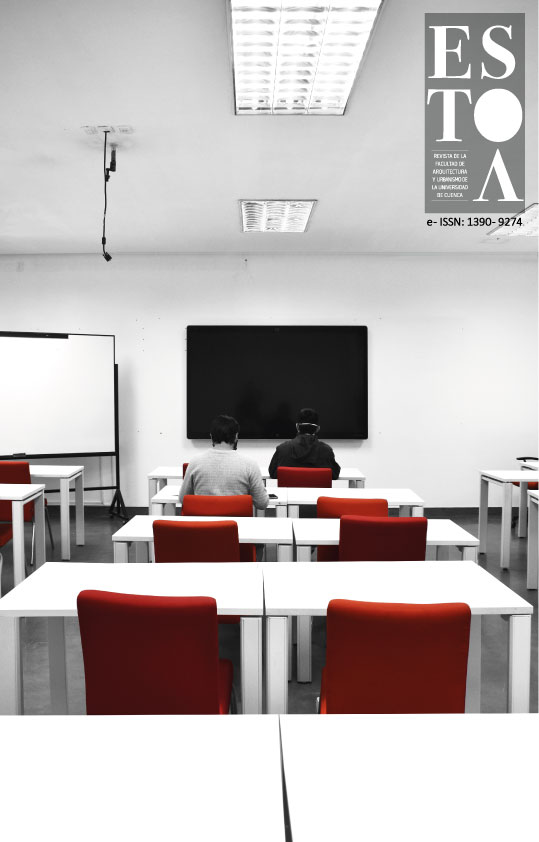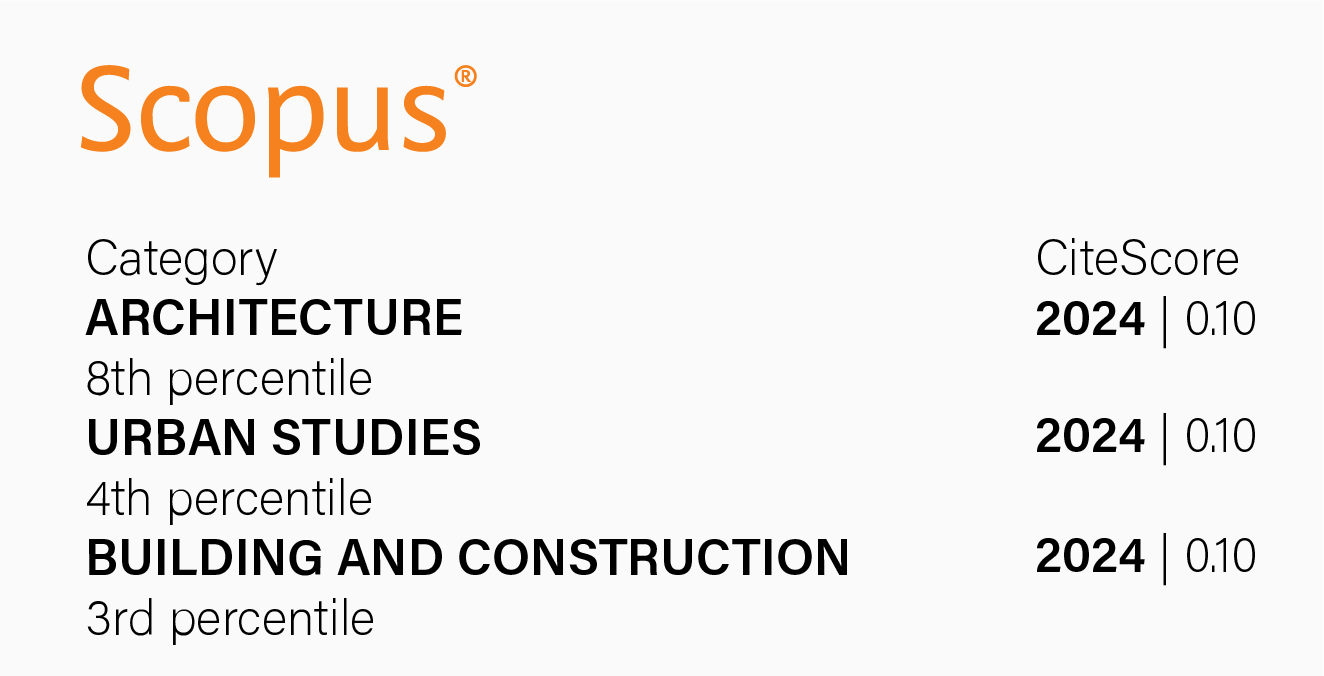Assessment of rural wall fortifications using SfM digital photogrammetry technique. Methodological application to Alhonoz Castle (Ecija, Spain)
DOI:
https://doi.org/10.18537/est.v009.n018.a09Keywords:
military architecture, digital photogrammetry, rammed-earth construction, damage, riskAbstract
The castle of Alhonoz, cataloged as Heritage Asset in 1985, is one of the most important fortresses in the municipality of Écija (Seville, Spain). The castle has been a strategic enclave for the populations settled in its environment since protohistoric times. In this study it is intended to implement the photo modelling as a tool into a methodology already tested by the authors. That methodology helps to contribute to the advance of knowledge of these defensive systems, allowing through a simple technique to obtain quickly, the necessary information to be able to evaluate and diagnose this type of structures. The implementation of this versatile and easy-to-use and low specialization methodology has enabled a reliable preliminary assessment for a decision making by competent technicians
Downloads
References
Becerra, J., Camacho Pérez, N. y Gomez-Villalba, L. (2013). Diagnóstico de patologías, caracterización mineralógica y estructural de la tapia pisada del Paredón de los Mártires (Bien de Interés Cultural colombiano) para trabajos de restauración. En 3er Congreso Iberoamericano y XI Jornada “Técnicas de Restauración y Conservación del Patrimonio.” La Plata, Argentina: Laboratorio de Entrenamiento Multidisciplinario para la Investigación Tecnológica - LEMIT.
Bianchini, M. (2008). Manuale di rilievo e di documentazione digitale in archeologia. Roma, Italia: Aracne.
Canivell, J. (2012). Characterization methodology to efficiently manage the conservation of historical rammed-earth buildings. En C. Mileto, F. Vegas y V. Cristini (Eds.), Rammed Earth Conservation (pp. 283–288). London, UK: Taylor & Francis Group.
Canivell, J., Rodríguez-García, R., González-Serrano, A. M. y Romero Girón, A. (2020). Assessment of heritage rammed-earth buildings. The Alcázar of King Don Pedro I (Spain). Journal of Architectural Engineering, 26 (2). doi: 10.1061/(ASCE)AE.1943-5568.0000400
Canivell, J., Jaramillo-Morilla, A., Mascort-Albea, E. J. y Romero-Hernández, R. (2020a). Methodological framework to assess military rammed-earth walls. The case of Seville city ramparts. En Science and Digital Technology for Cultural Heritage (pp. 83–87). London, UK: Taylor & Francis Group.
Canivell, J. y Graciani, A. (2015). Caracterización constructiva de las fábricas de tapia en las fortificaciones almohades del antiguo Reino de Sevilla. Arqueología de la Arquitectura, 12, e025. doi: 10.3989/arq.arqt.2015.003
Champiré, F., Fabbri, A., Morel, J. C., Wong, H. y McGregor, F. (2016). Impact of relative humidity on the mechanical behavior of compacted earth as a building material. Contruction and Building Materials, 110, 70–78. doi: 10.1016/j.conbuildmat.2016.01.027
Collantes de Terán, F. C. (1952). Los Castillos del Reino de Sevilla. Sevilla, España: Diputación Provincial de Sevilla.
García-Dils, S., Márquez Pérez, J. y Ordóñez Agulta, S. (2000). Sistemas de información geográfica aplicados al territorio de Écija: algunos ejemplos. En III Congreso de Arqueologia Peninsular Vol. VI, “Arqueologia da Antiguidade na Península Ibérica” (pp. 85–101). Oporto, Portugal: ADECAP. Associaçao para o Desenvolvimento da Cooperaçcao em Arqueologia Peninsular.
García-Pulido, L. J., Ruiz Jaramillo, J. y Alba Dorado, M. I. (2017). Heritage survey and scientific analysis of the watchtowers that defended the last Islamic kingdom in the Iberian Peninsula (thirteenth to fifteenth century). En ISPRS - International Archives of the Photogrammetry, Remote Sensing and Spatial Information Sciences. 26th International CIPA Symposium – Digital Workflows for Heritage Conservation (Vol. XLII-2/W5) (pp. 259–265). Ottawa, Canadá. doi: 10.5194/isprs-archives-XLII-2-W5-259-2017
Graciani, A. y Tabales, M. Á. (2008). El tapial en el área sevillana. Avance cronotipológico estructural. Arqueología de la Arquitectura, 5, 135–158. doi: 10.3989/arq.arqt.2008.93
Hernández Díaz, J., Sancho Corbacho, A. y Collantes de Terán, F. (1955). Catálogo arqueológico y artístico de la provincia de Sevilla. Sevilla, España: Diputación Provincial de Sevilla.
Lerma García, J. (2002). Fotogrametría moderna : analítica y digital. Valencia, España: Universidad Politécnica de Valencia.
López Osorio, J. M. (2012). Restauración de la Torre de los Secretos. Castillo de Baena (Córdoba). Loggia, Arquitectura & Restauración, (24–25), 64-75. doi: 10.4995/loggia.2012.2999
Martín-del-Río, J. J., Flores-Alés, V., Alejandre-Sánchez, F. J. y Blasco-López, F. J. (2018). New Method for Historic Rammed-earth Wall Characterization: The Almohade Ramparts of Malaga and Seville. Studies in Conservation, 64 (6), 363-372. doi: 10.1080/00393630.2018.1544429
Martínez Enamorado, V., Martínez Salvador, C. y Bellón Aguilera, J. (2007). A vueltas con la cronología del edificio del Castillejo de Monteagudo, Murcia: estudio de un epígrafe con el lema de los nazaríes y reflexiones sobre la metrología de sus tapias constructivas. Verdolay. Revista del Museo Arqueológico de Murcia, 10, 225–235.
Mileto, C., Vegas, F. y López, J. M. (2011). Criteria and intervention techniques in rammed earth structures: The restoration of Bofilla tower at Bétera (Valencia). Informes de la Construccion, 63(523), 81–96. doi: 10.3989/ic.10.014
Molina Rozalem, J. F. (2016). Fortificaciones de la Banda Morisca en la provincia de Sevilla. Sevilla, España: Diputación de Sevilla, Servicio de Archivo y Publicaciones.
Ortega, J., Vasconcelos, G., Correia, M., Rodrigues, H., Lourenço, P. B., y Varum, H. (2015). Evaluation of seismic vulnerability assessment parameters for Portuguese vernacular constructions with nonlinear numerical analysis. In M. Papadrakakis, V. Papadopoulos, & V. Plevris (Eds.), 5th ECCOMAS Thematic Conference on Computational Methods in Structural Dynamics and Earthquake. Crete Island, Greece.
Paris, L. (2012). Fotogrammetria e/o fotomodellazione. En Geometria descrittiva e rappresentazione digitale. Memoria e innovazione, II (pp. 55–62). Roma, Italia: Edizioni Kappa.
Peña-Villasenín, S., Gil-Docampo, M. y Ortiz-Sanz, J. (2019). Professional SfM and TLS vs a simple SfM photogrammetry for 3D modelling of rock art and radiance scaling shading in engraving detection. Journal of Cultural Heritage, 37, 238-246. doi: 10.1016/J.CULHER.2018.10.009
Quesada-García, S., y García-Pulido, L. J. (2015). El sistema de torres de origen medieval en el valle de Segura de la Sierra. La construcción de un paisaje. Boletín del Instituto de Estudios Giennenses, (212), 99–165.
Ramos, L., Masciotta, M., Morais, M., Azenha, M., Ferreira, T., Pereira, E. y Lourenco, P. (2018). HeritageCARE: Preventive conservation of built cultural heritage in the South-West Europe. En Innovative Built Heritage Models: Edited contributions to the International Conference on Innovative Built Heritage Models and Preventive Systems (CHANGES 2017). Leuven, Belgium: CRC Press. Taylor & Francis group.
Remondino, F. y Menna, F. (2008). Image-based Surface Measurement for Close-range Heritage Documentation. En The Int. Arch.of the Photogrammetry, Remote Sensing and Spatial Information Sciences. Vol. XXXVII-B Part B5 (pp. 199–206). Beijing, China.
Rodriguez-Navarro, P., Gil-Piqueras, T. y Verdiani, G. (2016). Drones for Architectural Surveying. Their Use in Documenting Towers of the Valencian Coast. En E. Castaño y E. Echevarría (Eds.), Architectural Draughtsmanship from analog to digital narratives, (pp. 1555-1566). Cham, Switzerland: Springer.
Silva, R. A., Mendes, N., Oliveira, D. V., Romanazzi, A., Domínguez-Martínez, O. y Miranda, T. (2018). Evaluating the seismic behaviour of rammed earth buildings from Portugal: From simple tools to advanced approaches. Engineering Structures, 157. doi: 10.1016/j.engstruct.2017.12.021
Stefani, C., Brunetaud, X., Janvier-Badosa, S., Beck, K., De Luca, L. y Al-Mukhtar, M. (2014). Developing a toolkit for mapping and displaying stone alteration on a web-based documentation platform. Journal of Cultural Heritage, 15(1), 1–9. doi: 10.1016/J.CULHER.2013.01.011
Tomás-Jover, R., Guill, A. J. R., González, M. C., Fernández, A. A. y Jordá, L. (2016). Structure from Motion (SfM): una técnica fotogramétrica de bajo coste para la caracterización y monitoreo de macizos rocosos. En Reconocimiento, tratamiento y mejora del terreno: 10º Simposio Nacional de Ingeniería Geotécnica (pp. 209-2016). A Coruña, España.
UNE-EN-16096. (2016). Conservación del patrimonio cultural. Inspección del estado e informe del patrimonio cultural construido. Madrid, España: AENOR.
Valor, M. (2004). Las fortificaciones de la Baja Edad Media en la provincia de Sevilla. Historia, Instituciones, Documentos, 31, 687–700.
Vegas, F., Mileto, C. y Cristini, V. (2014). Constructive features and preservation work of rammed earth architecture: the Islamic tower of Bofilla (Valencia). Journal of Architectural Conservation, 20(1), 28–42. doi: 10.1080/13556207.2014.886377
Walker, P. (2001). The Australian Earth building handbook. Sydney, Australia: Standards Australia International.
Wolf, P. y Dewitt, B. (2000). Elements of photogrammetry: with applications in GIS. Nueva York, Estados Unidos: McGraw-Hill.
Published
How to Cite
Issue
Section
License
The Journal declines any responsibility for possible conflicts derived from the authorship of the works that are published in it.
The University of Cuenca in Ecuador conserves the patrimonial rights (copyright) of the published works and will favor the reuse of the same ones, these can be: copy, use, diffuse, transmit and expose publicly.
Unless otherwise indicated, all contents of the electronic edition are distributed under a Creative Commons Attribution-NonCommercial-ShareAlike 4.0 International License.




